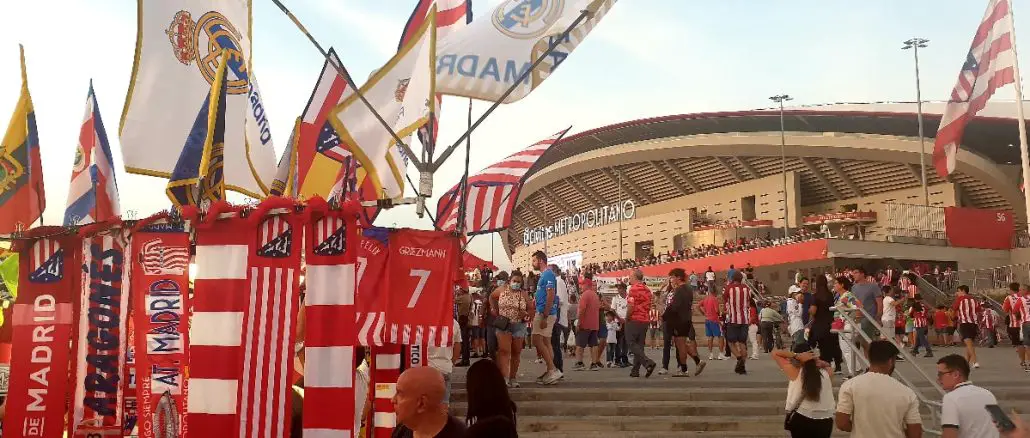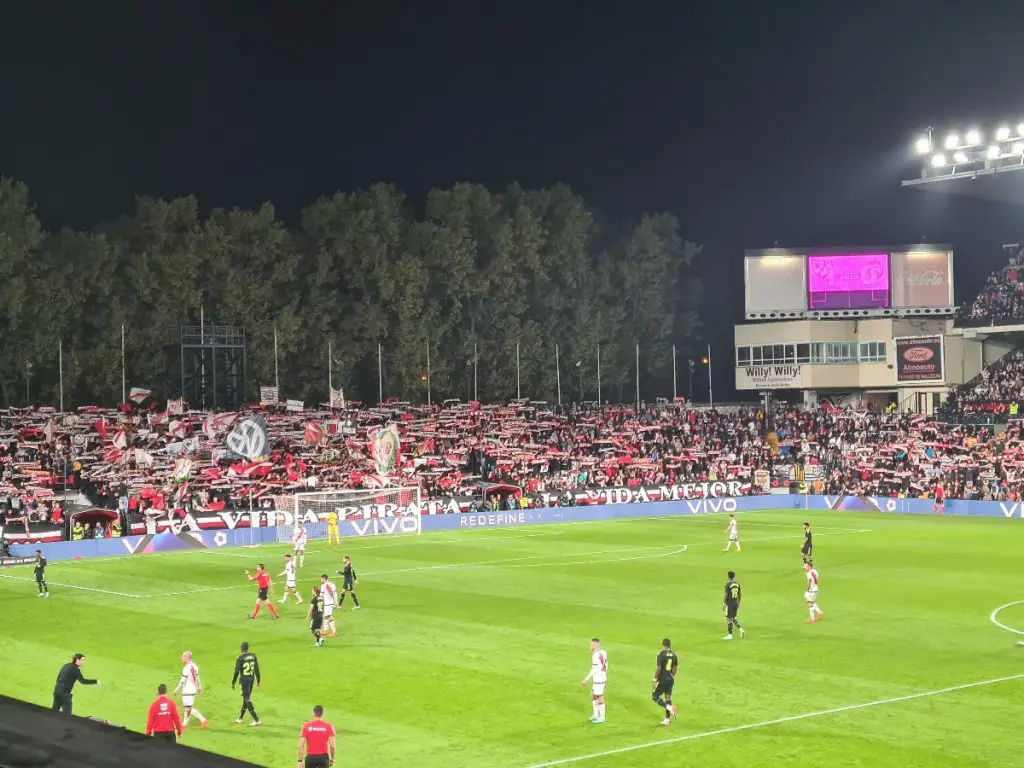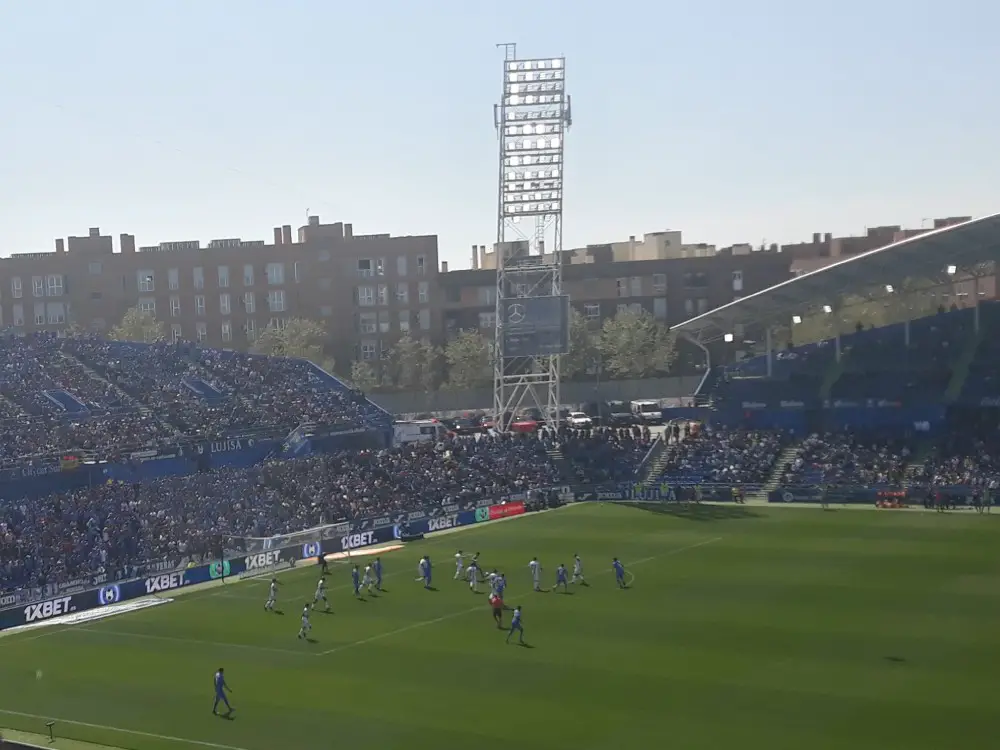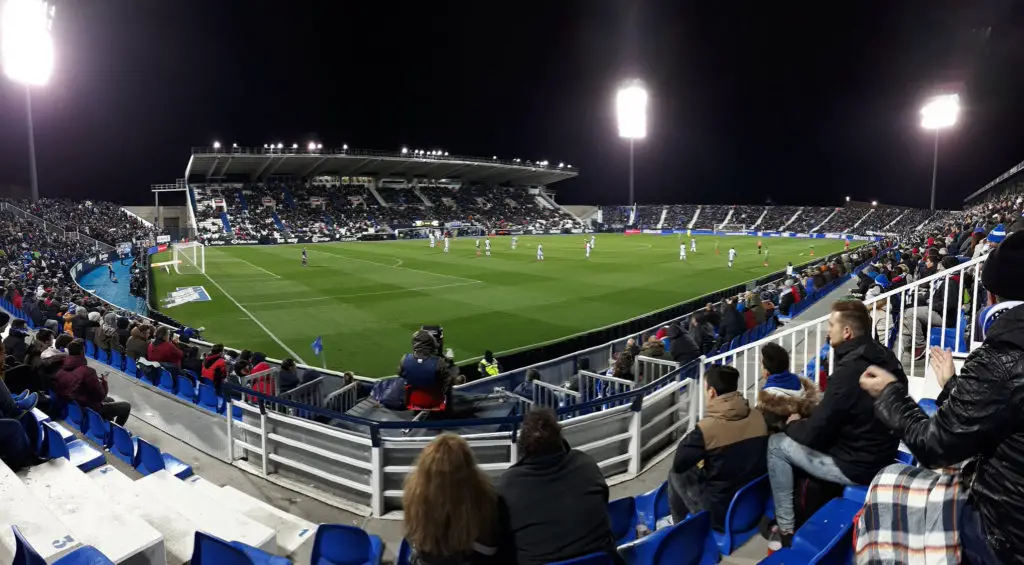
The Spanish capital has been described as the football capital of Europe in recent years, and there’s certainly something to that. It is the perfect destination for a football city break with loads of clubs packed into a relatively small area, almost all easily reached by public transport. In this Madrid football teams guide, we will aim to give you the lowdown on the game right across Spain’s largest metropolitan area.
The Madrid football map
The locations of all the main Madrid clubs feature above. The area is home to two of the largest Spanish football stadiums, with the homes of Real Madrid and Atletico Madrid, while Rayo Vallecano are also located within the city proper.
You can also see a cluster of clubs to the southwest of Madrid in the commuter belt that includes the towns of Getafe, Alcorcon and Leganes, all of which are represented by clubs in one of Spain’s top three tiers in the 2025/26 season.
There are many other clubs in the surrounding areas, but you need to dive down into the Segunda Federacion (fourth tier) or below to find those.
Madrid football teams
The big two
Real Madrid

Stadium – Santiago Bernabeu
Capacity – 81,044
Nearest metro station – Santiago Bernabeu
For any football visitor to Madrid, a trip to the Bernabeu is still likely to be at the top of the to-do list, despite the rise of their very noisy neighbours over the past 15 years. This, after all, is arguably the biggest football club in the world and they are way out on their own as the most successful team in the history of the European Cup with 15 titles, the most recent of which came in 2024.
Their home is found in an affluent northern area of Madrid and is easily reached from the centre. The Bernabeu has undergone extensive renovation work over the past few years and has its own metro station. It lies right on one of the city’s main thoroughfares – the famous Paseo de la Castellana.
How to buy tickets for Real Madrid matches:
Tickets can be bought online via the ticketing section of the official Real Madrid website. You can find release dates for all the upcoming matches, and once bought you simply need to download the mobile-friendly version of the ticket to your phone and show it at the gate.
Getting tickets for Madrid matches can be tricky due to high demand, meaning some games effectively sell out prior to reaching general sale (typically only a week before the match), with only the odd ticket cropping up after that. For bigger fixtures in LaLiga or the Champions League, you may want to consider alternative approaches if you’re desperate to secure a seat.
Official Real Madrid ticket-and-hotel packages are available further in advance via sportsbreaks.com, while you may have some joy on resale platforms such as Hellotickets, although any tickets bought via third-party sites are made at your own risk.
Real Madrid VIP tickets can also be bought directly from the club and are less likely to quickly sell out. They are available further in advance. You can also book stadium tours which cost from €35 for adults when booked online.
Atletico Madrid

Stadium – Metropolitano
Capacity – 70,460
Nearest metro station – Estadio Metropolitano
Atletico Madrid emerged in the 2010s as a genuine European superpower under the guidance of Diego Simeone. It was a decade in which they won every major competition they competed in besides the Champions League, despite two agonising near misses in finals against none other than their fierce city rivals.
They also moved from their historic old home on the banks of the Rio Manzanares to a shiny new stadium on the outskirts of the city, but so far have done a pretty good job of recreating that special Vicente Calderon atmosphere at their new ground.
How to buy tickets for Atlético Madrid matches:
Given the stadium can take up to an hour to reach from the centre of Madrid, you’re better off buying tickets online via the official Atleti website to avoid a wasted journey, not to mention a long queue.
Ticket prices are typically cheaper than those at the Bernabeu, with prices starting in the region of €30-40 for most league games and more for big Champions League matches or league games against Barcelona or Real Madrid. They do also sometimes run promos for certain games when tickets can be slashed to as low as €20.
Atletico Madrid ticket-and-hotel packages are also available further in advance via sportsbreaks.com, although it’s generally not difficult to get tickets via the club for all but the biggest fixtures.
Stadium tours cost €18 for children and €24 for adults when booked online. The Metropolitano is an impressive place, but it was only completed in 2017 so doesn’t have quite the same level of history or stories when compared to the Bernabeu. It’s also located in a fairly uninspiring part of Madrid.
For a side trip, take a walk along the river in Central Madrid between Puente de Segovia and Puente de Toledo for a feel for Atleti’s traditional heartland. The old stadium is sadly no more but was located here, close to the Puente de San Isidro.
The barrio boys
Rayo Vallecano

Stadium – Estadio de Vallecas
Capacity – 14,708
Nearest metro station – Portazgo
Rayo are certainly the hipster’s choice in Madrid and perhaps all of Spain. Their ultras are fiercely left-wing and they pride themselves on their anti-racism, anti-homophobia stances. They have historically been something of a yo-yo club between the Primera and Segunda divisions and their stadium is certainly one of the quirkiest to have graced the top flight.
At one end, there is nothing but a wall and a couple of tall apartment blocks, the balconies of which fill up whenever there’s a big game on with residents effectively getting a free season ticket. At the other end, the small Fondo is where the Rayo Ultras gather and it’s where the cheapest seats are to be found, although it’s rare that much sitting is done with a good atmosphere pretty much guaranteed, despite the low capacity.
It’s easy to reach, with Portazgo metro station literally on the doorstep of the stadium, in the working class barrio of Vallecas.
How to buy tickets for Rayo Vallecano matches:
Tickets for Rayo matches can start at as little as €20 in the exposed Fondo (behind the goal) or from €25-30 for one of the two main stands on either side of the pitch. It’s pretty good value for a team that has also been a good watch in recent years, enjoying periods of success under Andoni Iraola and Iñigo Perez who guided them to European qualification in the 2024/25 season.
The club is known for its horrendous organisation though, and tickets are not available online and usually only go on sale two or three days before each match from the club’s small ticket office. Expect queues and don’t leave it until the day of the game if you want to be certain of securing a ticket, as bigger matches do often sell out.
Pricing details are usually published in the main section of their website a few days before each game.
The South Madrid clubs
Getafe

Stadium – Coliseum
Capacity – 16,800
Nearest metro station – Los Espartales*
*It is usually quicker to take a Cercanias train to El Casar or Las Margaritas Universidad from Central Madrid.
Getafe were just one place off the bottom of the Segunda Division when Pepe Bordalas took over in September 2016. They went on a wild ride to briefly become genuine top-four contenders in LaLiga utilising a combative style that has rubbed many bigger names up the wrong way. Standards have dropped slightly over the past few years, but Bordalas is back after a short spell in Valencia, and Geta remain an established top-flight club.
Like most of the South Madrid teams, they are based in an unremarkable commuter town which experienced rapid population growth during the latter half of the 20th Century. It has taken time for the club, which was re-founded in 1983, to really kick on and grow their fanbase but they have established themselves as the most successful of the South Madrid clubs.
How to buy tickets for Getafe matches:
Tickets for Getafe matches can be bought online through the club and are always at least €40, even for the least glamorous games. The club does a pretty poor job of promoting themselves to the extent that you wonder if they even want people to come to their games. Crowds have increased at the Coliseum, but sell-outs are still quite rare.
Leganes

Stadium – Butarque
Capacity – 12,454
Nearest metro station – Julian Besteiro*
*It is usually quicker to take a Cercanías train to Zarzaquemada from Central Madrid.
Just 4 km to the west of Getafe’s Coliseum, you will find Leganes’ Estadio Municipal de Butarque. The duo contest what has risen to be the biggest South Madrid derby, a fixture that has even graced the top-flight stage in recent years after Leganes won promotion to LaLiga for the first time in 2016.
They returned for the 2024/25 season and beat the likes of Barcelona and Atletico Madrid, whilst also taking four points off Getafe, but that wasn’t enough to prevent relegation on the final weekend. They’ll be in the 2025/26 Segunda Division as a result.
How to buy tickets for Leganes matches:
Leganes are a friendlier and more open club than Getafe and one that does seem keen to accommodate visitors from abroad and draw in new fans. You can buy tickets online although there can sometimes be problems with foreign debit and credit cards.
Failing that, it should be possible to buy tickets at the stadium on matchday with their Segunda Division fixtures unlikely to sell out. They tend to offer some of the most affordable football tickets in Madrid.
The other South Madrid clubs
There are five sizable commuter towns to the south of Madrid and they are all connected by Line 12 of the Madrid metro. While Mostoles doesn’t currently have a team in the top four tiers on the Spanish football pyramid, all of the other towns have clubs that have flourished to some extent in recent years.
Aside from Getafe and Leganes, Alcorcon have spent much of their recent history in the Segunda Division, although they’ve since dropped down into the Primera Federacion (third tier) where they are the only representatives from the Comunidad de Madrid in the 2025/26 season, apart from the B teams of Real and Atletico who also play in that league.
Fuenlabrada were are also briefly a second-tier club, but they’ve since dropped two divisions into the Segunda Federacion. They play at the 5,400-capacity Estadio Fernando Torres, named after the legendary Spanish striker who was born in Fuenlabrada, but never played for the club.
The best of the rest
Along with Fuenlabrada, Rayo Majadahonda, Alcala, Colonia Moscardo, Navalcarnero and San Sebastian de los Reyes also represent the Madrid region in the 2025/26 Segunda Federacion.
Of those, the most interesting from a visitors perspective may be Alcala, who are based in the historic town of Alcala de Henares, which is an easy day or afternoon trip from Madrid. Colonia Moscardo are the easiest to reach given their location close to Usera metro station in a southern district of Madrid with a big Chinese influence.
You can also catch female football in Liga F, with Real Madrid, Atletico Madrid and Madrid CFF all playing in the top flight. Las Blancas play at the Estadio Alfredo Di Stefano in Valdebebas where the club’s training ground is located and they also frequently play in the UEFA Women’s Champions League.
Groundhopping in Madrid – Getting around

The three main clubs in the city itself (Real, Atleti & Rayo) can be easily reached by the Madrid metro via the stations listed above. You can buy the multi-card from any metro machine and can then load on tickets. The 10-trip (T-10) option (€6.10) is currently great value and is eligible for use on Zone 1 of the metro, TFM, metro Ligero 1 and metro Ligero Oeste, as well as city buses. This should be fine for seeing the city and getting to Atleti, Real Madrid or Rayo matches.
To reach the South Madrid clubs, it’s generally quicker to take the Cercanias which is a suburban rail network connecting Madrid to nearby towns and outer districts. The stations of Sol and Atocha in the centre of Madrid are well connected. The nearest Cercanias stations to the South Madrid football clubs are as follows:
- Getafe: El Casar or Las Margaritas Universidad (15-minute walk to stadium)
- Leganes: Zarzaquemada (20-minute walk to stadium)
- Alcorcon: Las Retamas (five-minute walk to stadium)
Buy single or return tickets in each case from any of the Cercanias (RENFE) machines found at any station – these are different from the metro machines and metro tickets (including the T-10) are not accepted on Cercanias services.
Football fans may also want to check out Legends: The home of football, a large, interactive museum in the very heart of the city.
Away from the football
Madrid has an enormous amount to see and do away from the football. While it is a capital, it still retains a friendly and relaxed vibe and most things to see are reachable on foot if you are based centrally.
Highlights include the glorious Parque Retiro, built around a large lake and one of the biggest leisure areas for Madrileños. Nearby to the park, there are several world-class museums and galleries including the Reina Sofia and El Prado.

Madrid is also a city of many famous squares. Puerta del Sol is very much the centre-point in the city and it’s useful to have this in mind for getting your bearings. Nearby is Plaza Mayor, possibly the most attractive square in all of Spain but expect to pay tourist prices if you eat and drink in any of its restaurants and bars. Plaza de España is less attractive but has played a big role in the recent history of the city.
If you want to get away from the more touristy parts and experience the city like a Madrileño, head to Malasaña. This district immediately to the north of the centre is full of small independent bars, restaurants, shops and little plazas. If you come to Madrid at the weekend, head to Calle de la Palma and the adjacent streets (Tribunal metro) for a night out away from the over-priced pubs and clubs near Puerta del Sol.
This is only really scratching the surface when it comes to things to do in Madrid. Other options include a trip on the Teleferico which will offer you great views of the city from the enormous Casa de Campo. If you come in the scorching hot summer, cool down at one of the city’s many outdoor pools, while the historic cities of Toledo and Segovia are among the best day-trip options.
About Author
You may also like
-
Official: Espanyol’s remarkable summer continues with 7th & 8th signings
-
Real Madrid star makes Kylian Mbappe return prediction
-
Real Madrid star equals Gareth Bale in club’s all-time goalscorer charts
-
Francisco Portillo sets record with five promotions to La Liga
-
Arsenal eye Eberechi Eze transfer and six other wingers